Summary
The ischaemic stop flow technique was used to study the effect of mersalyl, chlorothiazide and chlorthalidone in the distal segment of the dog nephron. It was found that chlorothiazide and chlorthalidone inhibit the reabsorption of Na+ and Cl−, but that mersalyl has no demonstrable effect on the transport of either ion in this region.
Similar content being viewed by others
References
Ashby, P., J. McEvoy, and K. Toal: The use of the ischaemic stop flow technique in quantitative studies of renal tubular functions. Cli. Sci. 31, 361 (1966).
Crosley, A. P., jr., R. C. Cullen, D. White, J. F. Freeman, C. W. Crumpton, C. A. Castillo, and G. G. Rowe: Studies of the mechanism of action of chlorothiazide in cardiac and renal diseases. J. Lab. clin. Med. 55, 191 (1960).
Earley, L. E., M. Kahn, and J. Orloff: The effects of infusions of chlorothiazide on urinary dilution and concentration in the dog. J. clin. Invest. 40, 857 (1961).
Frischauf, H., u. R. Wenger: Untersuchungen zur saluretischen Wirkung eines Sulphonamidderivates. Wien. med. Wschr. 111, 164 (1961).
Harvey, R. B., and A. J. Brothers: Renal extraction of para-aminohippurate and creatinine measured by continuous in vivo sampling of arterial and renal vein blood. Ann. N. Y. Acad. Sci. 102, 46 (1962).
Januszewicz, W., H. O. Heineman, F. E. Demartini, and J. H. Laragh: A clinical study of the effects of hydrochlorothiazide on the renal excretion of electrolytes and free water. New Engl. J. Med. 261, 264 (1959).
Kessler, R. H., K. Hierholzer, R. S. Gurd, and R. F. Pitts: Localisation of diuretic action of chlormerodrin in the nephron of the dog. Amer. J. Physiol. 194, 540 (1958).
Malvin, R. L., W. S. Wilde, A. J. Vander, and L. P. Sullivan: Localisation and characterisation of sodium transport along the renal tubule. Amer. J. Physiol. 195, 549 (1958).
Metaxas, P.: Stop flow technique using clamping of the renal pedicle to arrest movement of trapped urine. Cli. Sci. 23, 383 (1962).
Orloff, J., and R. W. Berliner: Ann. Rev. Pharmacol. 1, 299 (1961).
Schales, O., and S. S. Schales: A simple and accurate method for the determination of chloride in biological fluids. J. biol. Chem. 140, 879 (1941).
Stenger, E. G., u. H. Wirz: Pharmakologie und Wirkungsmechanismus von Hygroton. Chemotherapia 1, 254 (1960).
Varley, H.: Practical clinical biochemistry, 2nd ed. London: W. Heinemann Ltd. 1958.
Author information
Authors and Affiliations
Rights and permissions
About this article
Cite this article
McEvoy, J. Localisation of the site of action of mersalyl, chlorothiazide and chlorthalidone in the renal tubule using the ischaemic stop flow technique. Naunyn-Schmiedebergs Arch. Pharmak. u. Exp. Path. 259, 314–318 (1968). https://doi.org/10.1007/BF00536905
Received:
Issue Date:
DOI: https://doi.org/10.1007/BF00536905




